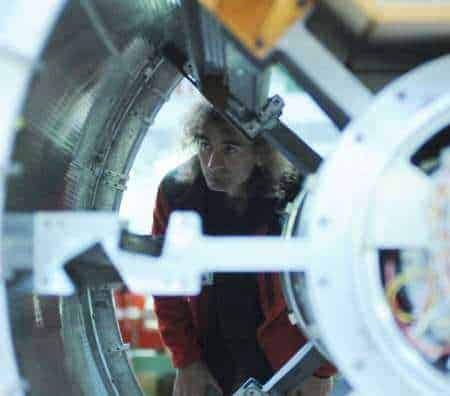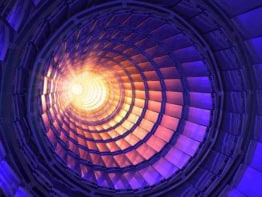
Scientists at the Italian particle accelerator DAFNE are looking forward to an era of new physics having implemented an upgrade that is boosting the rate at which the machine can collide electrons and positrons. Their success paves the way for a new accelerator that is over 10 times as big with 10 times more energy.
The upgrade, which was completed five months ago, has already doubled the luminosity of DAFNE’s electron–positron collisions. Over the coming months the scientists think that it should be possible to make the luminosity three to six times higher.
“It’s increasing as we speak,” says Pantaleo Raimondi, project leader and researcher at the National Institute of Nuclear Physics, during a phone interview. “More luminosity means a higher collision rate, more particles and therefore more physics.”
Luminosity is increasing as we speak Pantaleo Raimondi, DAFNE
DAFNE is a compact, circular accelerator based at the Frascati National Laboratories, near Rome. It has two storage rings, each 100 m long, that accelerate electron and positron beams to energies of 0.5 GeV. At one point in the rings the electrons and positrons are extracted and then smashed into each other, before the remainders of the beams are re-entered into the ring.
The collisions produce phi-mesons, short-lived particles that contain a strange quark bound to a strange anti-quark. By studying the decays of these mesons — particularly into lighter kaons — scientists at DAFNE have been able to spend the best part of a decade studying aspects of particle physics such as quantum chromodynamics and CP violation.
‘As we hoped’
When it was built in 1997, DAFNE was deemed the world’s first particle “factory” because of its copious output of phi-mesons. The aim of the upgrade, which was implemented over the latter half of last year, was to see whether this factory could be made far more productive for minimal cost. If the upgrade was a success, it would prove the concept for a “super factory” called SuperB — a larger circular accelerator that will investigate the decays of heavier B-mesons. “Everything is performing exactly as we hoped, as we expected,” says Raimondi.
The upgrade has altered the geometry of the electron and positron beams to collide them at more of an angle. Although intuition would say that head-on collisions would give the highest luminosity, this arrangement leads to so much disruption that only a small remainder of the uncollided beams can be salvaged to re-enter into the rings.
An oblique collision reduces the disruption, but it comes with its own side-effect: it deters the beams from colliding at the point where the accelerator’s magnets force them to be thinnest. Raimondi and his team came up with the idea of giving the beams a “crabbed waist” — essentially tilting and rotating them — to make this thin point accessible again.
The upgrade has required around 60% of DAFNE’s rings to be modified at a cost of just €1.5m, which is modest considering the €150m value of DAFNE itself. The engineers are currently improving the accelerator’s detectors to exploit the large volumes of phi-mesons so that their decay processes can be measured more accurately.
‘Stepping stone’
With the upgrade already providing significant increases to DAFNE’s luminosity, the INFN and other institutions can concentrate on the design of SuperB, which will be constructed nearby. “It’s fantastic news,” says Tim Gershon at the University of Warwick, UK. “It’s a very important development in accelerator physics. It has immediate applications at DAFNE that could revitalize the programme. And it’s an important stepping stone for the SuperB factory.”
By putting all of these various things together we can get sets of measurements that complement those at the LHC Tim Gershon, University of Warwick
The measurements of B-meson decay processes will be important in testing particle physics beyond the current Standard Model. The behaviour of B-mesons is influenced by virtual particles that pop in and out of existence by borrowing energy from the vacuum, giving researchers a handle on particles that are too heavy to be produced directly (see this month’s Physics World feature: “A taste of LHC physics”).
There are already experiments looking into B-meson decay processes, including the Belle experiment at the KEK laboratory in Japan and the BaBar experiment — which was recently shutdown — at the Standford Linear Accelerator Centre in the US. There is also the LHCb experiment, which will start when the European laboratory CERN brings the Large Hadron Collider (LHC) online later this year.
SuperB, however, will be able to look for physics that would otherwise be out of reach. For example, it will be able to measure the decay of a B+-meson into a tau-lepton and a tau-neutrino — a process that the LHCb is not sensitive enough to measure.
In general, the B-meson factories give a different approach to direct particle searches, such as the LHC’s ATLAS and CMS detectors. “By putting all of these various things together we can get sets of measurements that complement those at the LHC,” says Gershon.



